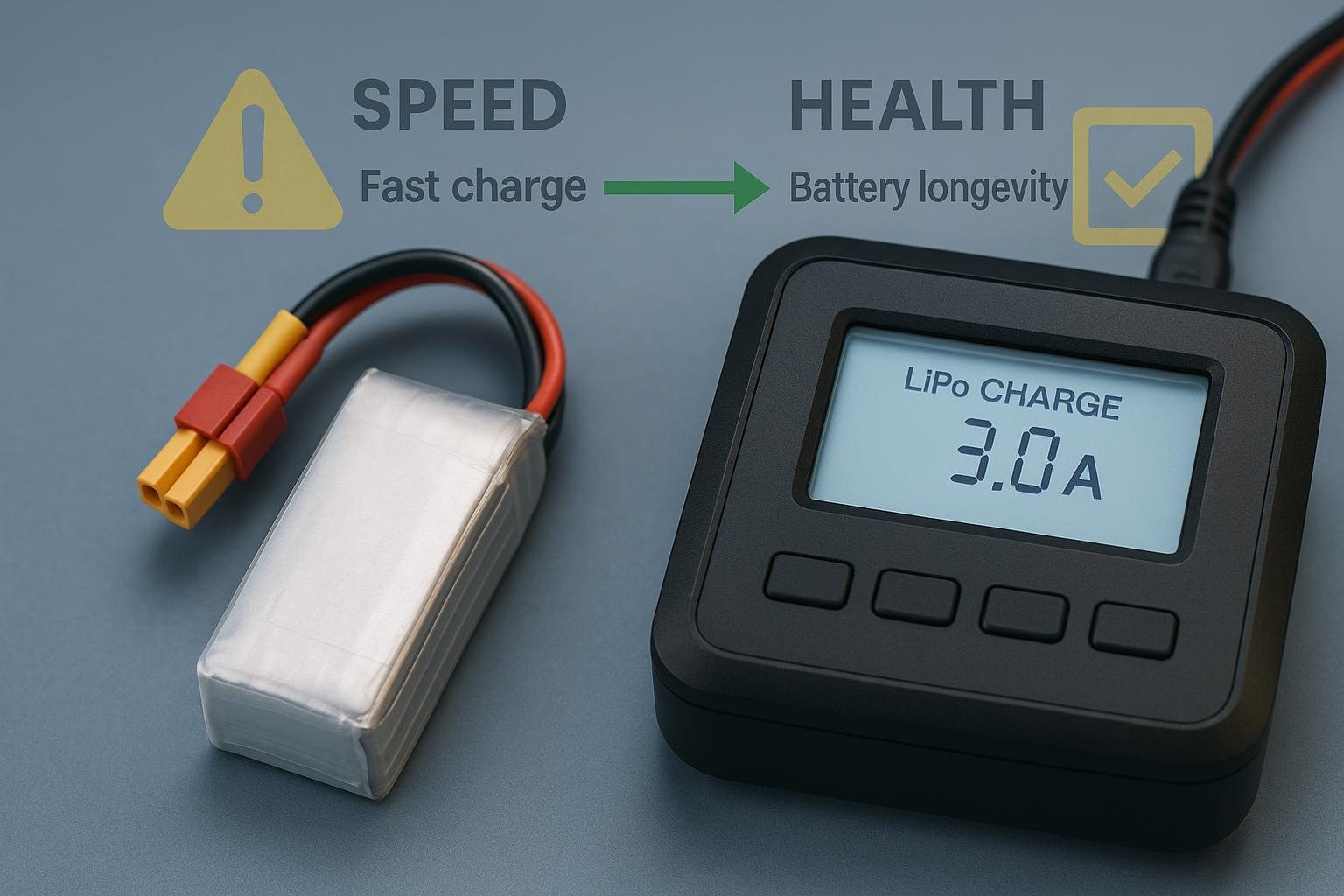
Achieving the perfect balance of quick charging and healthy, long-lasting LiPo batteries is both an art and a science. This guide gives you clear, step-by-step instructions to safely choose your LiPo charging rate—whether you fly drones, race RC cars, or rely on LiPo packs in electronics.
Why Charging Rate Matters
- Carga rápida saves time but can shorten battery lifespan or cause dangerous failures if your pack can’t keep up.
- Slower charging (following the 1C rule) maximizes battery cycles and health, reducing risk of overheating or swelling.
- [1mCorrectly setting your charger means safer operation and lower long-term costs.[0m
Understanding C-Rate & Battery Capacity
What Is the C-Rate?
The C-rate tells you how quickly a battery can be safely charged or discharged. For most LiPo batteries:
- 1C = Charge current equal to battery capacity (in Ah).
- Most batteries are safely charged at 1C unless the label/manual says otherwise.
Decoding Your Battery’s Label:
- Capacidad: Labeled in mAh (e.g., 2200mAh)
- Max Charge Rate: Sometimes listed as a C value (e.g., “Max Charge 2C”), sometimes not
- Cell Count: (e.g., 3S for 3 cells)
Fórmula:
Charge Current (Amps) = Battery Capacity (mAh) �f7 1000 �d7 C-rate
Example (1C, 2200mAh): 2200 �f7 1000 = 2.2A
Quick-Reference Charge Rate Table (1C)
| Battery Capacity (mAh) | 1C Charge Rate (A) |
|---|---|
| 500 | 0.5 |
| 1000 | 1.0 |
| 1500 | 1.5 |
| 2200 | 2.2 |
| 5000 | 5.0 |
Consejo: [1mIf in doubt, always use 1C for your first charge unless the battery manufacturer specifies otherwise.[0m
Step-by-Step: Selecting & Setting Your LiPo Charging Rate
[1mLiPo Charging Checklist[0m
- Review Battery Label: Find the capacity in mAh, cell count (S), and any max charge rate (C).
- Read the Manual: If your battery/manual explicitly allows faster than 1C, you may go higher.
- Calculate Safe Charge Current:
- Use the formula: Capacity (mAh) �f7 1000 �d7 C-rate (default 1C)
- Example: 1500mAh �f7 1000 = 1.5A (at 1C)
- Set Charger:
- Select LiPo mode (NOT NiMH/NiCd)
- Enter cell count (matches ‘S’ on label)
- Set charge current (e.g., 1.5A for 1500mAh at 1C)
- Use Balance Charge mode for safety
- Prepare Your Space:
- Use a fireproof charging bag/box
- Ventilated, clear area, away from flammable items
- Connect Cables:
- Attach main and balance leads (check polarity)
- Double-Check Display:
- Correct voltage & cell count; current is as calculated
- Start Charging – Supervise!:
- Stay close; never leave charging LiPos unattended
- Monitor Progress:
- Battery should get only slightly warm
- If swelling, overheating, or odd smells occur STOP IMMEDIATELY
- Charging Done:
- Disconnect balance lead first, then main
- Store at 3.8V/cell if not used immediately
✔️ Printable Safe Charging Checklist (PDF)
Balancing Speed vs. Longevity: The Numbers
Standard 1C charging:
- Full charge time: ~50–75 minutes for most packs
- Cycle life loss: Minimal; rated life (150–300+ cycles) preserved
Faster charging (2C, 3C & above):
- Time saved: Cuts charge in half (2C) or a third (3C)
- Cycle life cost: Industry data suggests 10–25% fewer total cycles (especially if used regularly)
- Safety risk: Higher (heat, possible swelling)
| Tarifa | Time for 2200mAh | Expected Cycles | Risk Level |
|---|---|---|---|
| 1C (2.2A) | ~60 min | 200–300 | Bajo |
| 2C (4.4A) | ~30–35 min | 150–200 | Medium (needs label) |
| 3C (6.6A) | ~20–25 min | 100–130 | High (only if rated) |
Boxed Warning: Never attempt 2C/3C charging unless your battery and charger both specifically allow it. When in doubt, stick to 1C.
Troubleshooting & Warnings
| Symptom | Indicates | Acción |
|---|---|---|
| Excessive heat | Too high current | Stop charging, reset to 1C |
| Swelling/puffing | Battery damage | Discontinue use, dispose safely |
| Charger error code | Imbalance, mismatch | Check connections, cell count |
| Charge incomplete | Connection/voltage err | Inspect and retest all leads |
- If battery gets hot or swells, move to a fire-safe place immediately and never recharge it.
- Inspect balance leads and connectors for corrosion or damage if you see error codes.
- For unclear specs, always default to 1C and consult the manufacturer’s website.
More Help
FAQs: Making the Best Choice Every Time
What if my battery’s max charge rate isn’t listed?
Use 1C by default, which is safe for virtually all modern LiPo packs.
Is it OK to fast-charge for special events?
Occasional use of 2C+ is possible if your battery and charger allow it, but expect reduced lifespan.
My charger doesn’t let me dial in the exact calculated amperage—what should I do?
Round down. Always stay under the max rating.
How should a battery feel during charge?
Should stay cool or only slightly warm. Heat = warning; swelling = danger.
Can I parallel charge multiple packs?
Yes, but only if you’re experienced and every pack is the same cell count, state, and health. Risks are higher! Consult detailed guides first.
For more, see: EuroRC LiPo Guide, Oscar Liang’s Guide.
Key Takeaways
- Prioritize 1C charging for safety and battery health.
- Always check both battery and charger specs before adjusting current.
- Monitor battery during every charge. If anything feels off, stop immediately.
- Use resources & checklists to simplify your workflow.
Recursos adicionales
- LiPo Battery C-rate Calculator
- Download Charging & Safety Checklist
- Comprehensive LiPo Battery Guide by Oscar Liang
Stay informed, stay safe, and enjoy longer-lasting, high-performing LiPo batteries by following these best practices!
Referencias: EuroRC Charge Guide, Ufine Battery C-rate Info, HobbyKing Error Codes, Oscar Liang’s LiPo Battery Guide (all links verified as of 2024).

